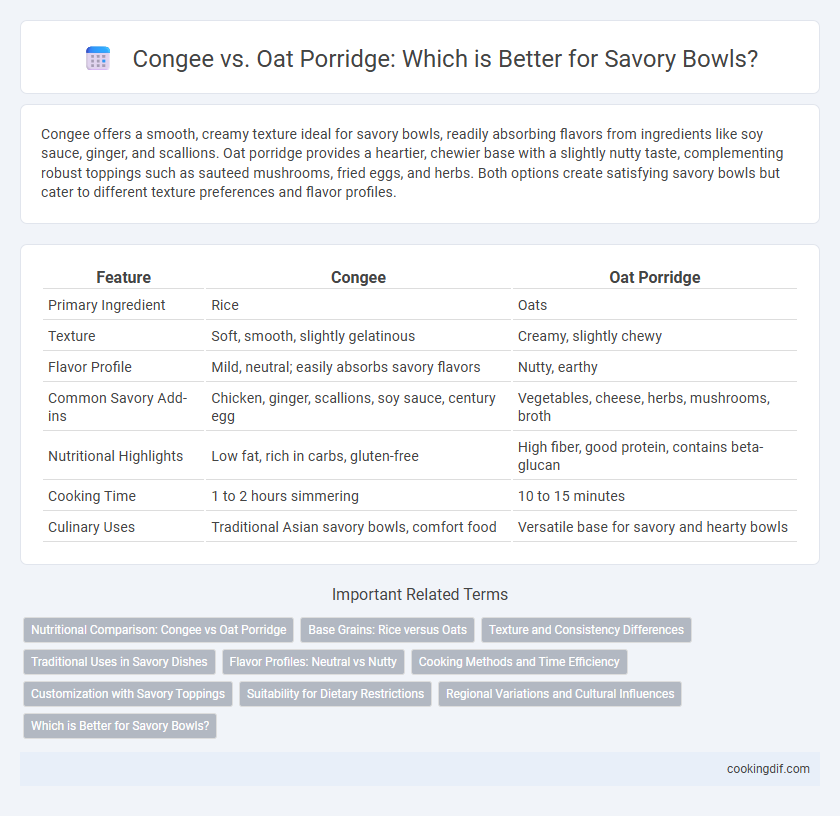Congee offers a smooth, creamy texture ideal for savory bowls, readily absorbing flavors from ingredients like soy sauce, ginger, and scallions. Oat porridge provides a heartier, chewier base with a slightly nutty taste, complementing robust toppings such as sauteed mushrooms, fried eggs, and herbs. Both options create satisfying savory bowls but cater to different texture preferences and flavor profiles.
Table of Comparison
| Feature | Congee | Oat Porridge |
|---|---|---|
| Primary Ingredient | Rice | Oats |
| Texture | Soft, smooth, slightly gelatinous | Creamy, slightly chewy |
| Flavor Profile | Mild, neutral; easily absorbs savory flavors | Nutty, earthy |
| Common Savory Add-ins | Chicken, ginger, scallions, soy sauce, century egg | Vegetables, cheese, herbs, mushrooms, broth |
| Nutritional Highlights | Low fat, rich in carbs, gluten-free | High fiber, good protein, contains beta-glucan |
| Cooking Time | 1 to 2 hours simmering | 10 to 15 minutes |
| Culinary Uses | Traditional Asian savory bowls, comfort food | Versatile base for savory and hearty bowls |
Nutritional Comparison: Congee vs Oat Porridge
Congee, a rice-based porridge, is low in calories and carbohydrates, making it easily digestible and suitable for savory bowls with vegetables and proteins. Oat porridge contains higher fiber, protein, and healthy fats, contributing to sustained energy and improved heart health. Both offer essential nutrients, but oats provide greater satiety and micronutrient density compared to the lighter, more hydrating congee.
Base Grains: Rice versus Oats
Congee and oat porridge serve as versatile bases for savory bowls, with rice providing a smooth, creamy texture that absorbs flavors deeply, ideal for rich broths and umami-rich toppings. Oats offer a heartier, chewier base that retains more structure, enhancing the textural contrast in savory dishes and adding a nutty flavor profile. Rice congee's neutral taste makes it a perfect canvas for bold seasonings, while oats contribute additional fiber and nutrients, making each grain choice suited to different culinary preferences and nutritional goals.
Texture and Consistency Differences
Congee offers a smooth, creamy texture achieved by slow-cooking rice in abundant water until it breaks down into a thick, porridge-like consistency ideal for savory bowls. Oat porridge features a chewier, heartier texture with visible oat grains, providing a more substantial bite and varied mouthfeel suitable for robust savory toppings. The water-to-grain ratio and cooking time primarily influence the consistency, making congee silkier while oat porridge retains more structure and density.
Traditional Uses in Savory Dishes
Congee, a traditional rice porridge deeply rooted in Asian cuisine, serves as a versatile base for savory bowls enriched with ingredients like scallions, soy sauce, and preserved eggs. Oat porridge, often associated with Western breakfasts, is adapted for savory dishes by incorporating toppings such as sauteed mushrooms, herbs, and cheese to create hearty meals. Both porridges emphasize texture and flavor absorption, making them fundamental staples in diverse savory culinary traditions.
Flavor Profiles: Neutral vs Nutty
Congee offers a mild, neutral flavor that serves as an ideal base for savory bowls, allowing bold spices, herbs, and umami-rich toppings to shine. Oat porridge presents a naturally nutty taste that adds depth and warmth, complementing savory ingredients like roasted vegetables, cheeses, and savory sauces. Choosing between congee and oat porridge depends on whether a subtle backdrop or a richer, earthier flavor profile is preferred for the dish.
Cooking Methods and Time Efficiency
Congee typically requires long simmering times, often several hours, to achieve its characteristic creamy texture, making it less time-efficient for quick savory bowls. Oat porridge cooks rapidly, usually within 5 to 10 minutes, allowing for faster meal preparation while maintaining a hearty consistency ideal for savory toppings. Pressure cooking congee can reduce cooking time significantly, yet oats remain the preferred choice for quick savory porridge due to their naturally shorter cooking times and ease of customization.
Customization with Savory Toppings
Congee offers a smooth, rice-based canvas that easily absorbs savory toppings like scallions, soy sauce, and century eggs, creating deeply flavored, customizable bowls. Oat porridge provides a hearty, textured base that pairs well with robust ingredients such as sauteed mushrooms, cheese, and herbs for a satisfying savory meal. Both options support versatile customization, catering to diverse taste preferences and dietary needs in savory porridge dishes.
Suitability for Dietary Restrictions
Congee, a rice-based porridge, is naturally gluten-free and easily digestible, making it highly suitable for individuals with gluten intolerance or sensitive stomachs. Oat porridge contains beta-glucan fiber, beneficial for heart health, but may not be suitable for those with celiac disease unless certified gluten-free oats are used. Both options can accommodate various dietary restrictions when paired with appropriate savory toppings, though congee's neutral taste offers more versatility for low-sodium or low-fat diets.
Regional Variations and Cultural Influences
Congee, a staple in East Asian cuisine, is typically made from rice and embodies regional variations with savory additions like pickled vegetables, century eggs, or pork in China, while oat porridge, popular in Western and Scandinavian cultures, incorporates ingredients such as smoked salmon, herbs, and cheese for a savory twist. The cultural influence on congee emphasizes its role in comfort food and medicinal diets, whereas oat porridge aligns more with rustic, hearty breakfasts rooted in agrarian traditions. Both dishes reflect their unique geographic and cultural contexts through diverse toppings and preparation methods that enhance their savory profiles.
Which is Better for Savory Bowls?
Congee, a rice-based porridge, offers a neutral and smooth texture ideal for absorbing savory flavors like soy sauce, ginger, and scallions, making it a versatile base for Asian-inspired savory bowls. Oat porridge has a thicker, creamier consistency with a slightly nutty flavor, which pairs well with hearty ingredients like roasted vegetables, cheese, or eggs in savory dishes. For authentic savory bowls requiring delicate flavor absorption and a light texture, congee is often preferred, while oat porridge suits bolder, creamier savory recipes.
Congee vs oat porridge for savory bowls Infographic

 cookingdif.com
cookingdif.com